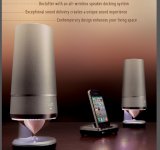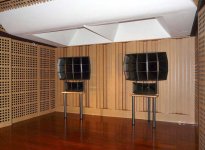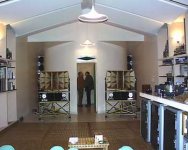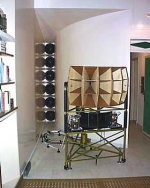nice room acoustics treatment!
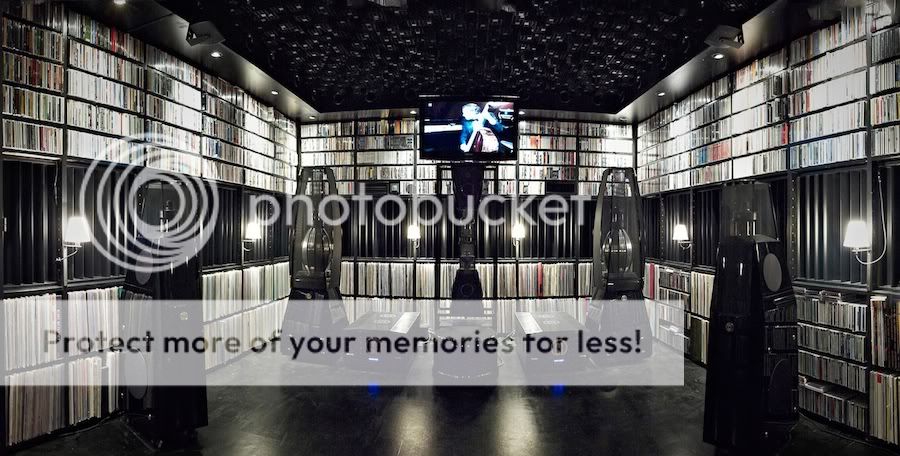
Reminds me of something......
An externally hosted image should be here but it was not working when we last tested it.
Impressive "mise en scène", but I think that this room is too small for starting with these speakers
why? walls too close, reflections too strong and too early and so on?
I think also that the happy owner would consider a PC based server as a source.
OTOH more LPs instead of cds would result in even better treatment and better sound
using five bare driver flooders instead of those five monsters of overengineering could also help
Last edited:
These MBL need much more space to give their best,
but why?
and here, honestly I don't understand the layout. Where is supposed to sit the listener ?
can't You understand that the greatness of such a system doesn't need any listener at all
He is supposed to be in His private jet instead, on another one business trip
He's got the picture in His wallet, the system looks terrific
(no seat in such a room - if really necessary the listener is to be suspended from the ceiling, criogenically treated first, of course)
Last edited:
Where is supposed to sit the listener ?
The stool at the center between the 2 giant amps?
Might also save the heater in winter
I say this (MBL needs big rooms) not because I own a pair, but because in this forum all those who liked them have been listening in rather large rooms, as all those who disliked were in small ones. Just a poor man's guess.
I dunno what's the round thing in the middle. Normally this kind of guy buys all the elements from the same brand, and this is not in the mbl catalog. Maybe an assorted chemical toilet ?
I dunno what's the round thing in the middle. Normally this kind of guy buys all the elements from the same brand, and this is not in the mbl catalog. Maybe an assorted chemical toilet ?
Last edited:
but because in this forum

yes indeed
the research Mr Jones refers to is the so-called "Archimedes" Eureka-funded research project: Project - EUREKA
it was joint project of Danmarks Tekniske Universitet, Bang & Olufsen and KEF
Bech is now Head of Research at Bang & Olufsen
on the part of Bang & Olufsen the follow-up to the project was the decision to licence the acoustic lens from Sausalito (of Moulton and LaCarruba) and to introduce their current line of horizontally omnidirectional Beolab speakers
what Jones says in this recent interview is the same what Moulton said in His 1999 interview for Recording Magazine: Moulton Laboratories :: Nick Batzdorf Interviews David Moulton
linked here many times
both gentlemen refer to the same "Archimedes" research project led by Bech, no wonder their conclusions are the same
Bech - praised here on diyaudio for His scientific publications - is in fact the man behind B&O-Moulton coooperation and Beolab line of omni speakers:
http://www.bang-olufsen.com/graphics/bogo/News/BeoLab5-PR/BeoLab5_Pressrelease.pdf
yes indeed
both gentlemen refer to the same "Archimedes" research project led by Bech, no wonder their conclusions are the same
Hmm, but there products are very different. the IRIS product that Jones designs for TAD has higher than normal directivity while Moulton aims for cylindrical omni.
Are they both following the teaching of Bech?
David S
Hmm, but there products are very different. the IRIS product that Jones designs for TAD has higher than normal directivity while Moulton aims for cylindrical omni.
Are they both following the teaching of Bech?
David S
Bech at B&O clearly follows His own teaching, Beolab speakers line is not Moulton's but Bech's, Bech is the Head of Research at B&O and the man behind Beolab line, not Moulton, Moulton's is just the lens
I can't say why Jones doesn't "follow teaching of Bech" in His commercial designs
perhaps part of the answer lies in the fact that His part was just "setting it up and formatting the experimental apparatus" and that all He has to say about it now in the interview, by way of conclusion, is that it just was "really interesting"
Last edited:
ps.
but the real answer to the question is to be found at the marketing departments, an omni speaker just wouldn't work as KEF's or TAD's product, marketing-wise, because it doesn't fit the image of the company and expectations of it's target market, being too different from the competition
B&O is a different story, B&O customers rather expect the company to introduce highly original products, significantly different from the competition
but the real answer to the question is to be found at the marketing departments, an omni speaker just wouldn't work as KEF's or TAD's product, marketing-wise, because it doesn't fit the image of the company and expectations of it's target market, being too different from the competition
B&O is a different story, B&O customers rather expect the company to introduce highly original products, significantly different from the competition
Hi,
Except of course, these are not "Omni Speakers", but controlled wide horizontal, narrow vertical dispersion speakers.
Ciao T
Beolab line of omni speakers
Except of course, these are not "Omni Speakers", but controlled wide horizontal, narrow vertical dispersion speakers.
Ciao T
Hi,
Well, Andrew Jones (who I agree knows a lot about speakers) in the previously referenced interview seems to disagree, he suggests an Omni is not a good idea for technical reasons:
You are right that B&O COULD make Omni's if it so choose (or even speakers following the Bose formula with 8/9 reflected sound or whatever).
However, isn't it telling that due to their co-operation with Sauselito Audio Works / Moulton they make in fact speakers that are quite controlled directivity and narrow directivity in the vertical plane?
Ciao T
but the real answer to the question is to be found at the marketing departments, an omni speaker just wouldn't work as KEF's or TAD's product, marketing-wise
Well, Andrew Jones (who I agree knows a lot about speakers) in the previously referenced interview seems to disagree, he suggests an Omni is not a good idea for technical reasons:
Andrew Jones said:Which gets us back to what are, truly, the important speaker characteristics. It confirmed a lot of beliefs that ceiling reflections are one of the worst. Sidewall reflections can be good, adding to a sense of spaciousness, if the stereo speaker possesses well-controlled directivity. This same sidewall phenomenon happens in concert halls, on a different scale. The tall, narrow, long concert halls -- traditional ones -- were always the best halls. Sidewall reflections are lower-correlation than ceiling or floor, so they add spaciousness. Correlated signals, by contrast, add coloration.
B&O is a different story, B&O customers rather expect the company to introduce highly original products, significantly different from the competition
You are right that B&O COULD make Omni's if it so choose (or even speakers following the Bose formula with 8/9 reflected sound or whatever).
However, isn't it telling that due to their co-operation with Sauselito Audio Works / Moulton they make in fact speakers that are quite controlled directivity and narrow directivity in the vertical plane?
Ciao T
Hi,
Except of course, these are not "Omni Speakers", but controlled wide horizontal, narrow vertical dispersion speakers.
Ciao T
yes, You are right of course, they just shoot 180 degrees horizontally so side wall reflections are as loud as the can be, it is just like omni in this particular respect
thanks for clarification
Hi,
Well, Andrew Jones (who I agree knows a lot about speakers) in the previously referenced interview seems to disagree, he suggests an Omni is not a good idea for technical reasons:
yes, I think that they all - Jones, Bech, Moulton - agree that a real 720 degrees omni is not good
I agree too
I am sorry for ambiguous misuse of the word "omni"
it was a er... mental shortcut
Impressive "mise en scène", but I think that this room is too small for starting with these speakers whatever could be the claims and benefits of the room treatment.
I think also that the happy owner would consider a PC based server as a source.
I can see this making some sense. When I used to design teleconference rooms, it was standard practice to use a hard ceiling to increase the direct/reverb ration for participants at the back of the room.
Increasing early reflection density with speaker listening would have a similar effect and allow more of the direct sound to dominate over the later reverb, in theory increasing intelligibility. Using early diffraction, there is less tonal distortion due to the early reflection.
IME FWIW, lack of early refection does sound deader, but imaging outside the speakers (when the recording expects it) is better.
Thinking of loudspeaker and room as a system made me remember these two rooms. Certainly a good blend of room and speaker.
In one, the wall is the horn woofer, in the other the ceiling is.
In one, the wall is the horn woofer, in the other the ceiling is.
Attachments
I can see this making some sense. When I used to design teleconference rooms, it was standard practice to use a hard ceiling to increase the direct/reverb ration for participants at the back of the room.
Increasing early reflection density with speaker listening would have a similar effect and allow more of the direct sound to dominate over the later reverb, in theory increasing intelligibility. Using early diffraction, there is less tonal distortion due to the early reflection.
IME FWIW, lack of early refection does sound deader, but imaging outside the speakers (when the recording expects it) is better.
The above was supposed to be in response to graafs post:
looks like this different way of treating a room (an example above) is actually inspired by Stig Carlsson's ortoacoustic theories
- Home
- Loudspeakers
- Multi-Way
- The Advantages of Floor Coupled Up-Firing Speakers

